
Music of Nepal refers to the various musical genres played and listened to in Nepal. With more than fifty ethnic groups in Nepal, the country's music is highly diverse. Genres like Tamang Selo, Chyabrung, Dohori, Adhunik Geet, Bhajan, Filmi music, Ghazal, Classical music, songs and Ratna music are widely played and popular, but many other less common genres are yet to be cataloged. Western musical genres like Rock, Metal, Hip-Hop, Rap, R&B also regularly feature on the Nepalese music charts. Most of the country's musical bands are based in the Kathmandu valley. Musical genres from Tibet and India have greatly influenced Nepalese music.
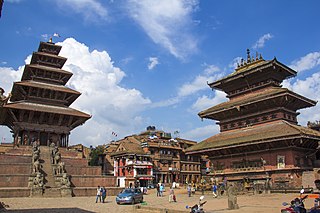
Bhaktapur, known locally as Khwopa and historically called Bhatgaon, is a city in the east corner of the Kathmandu Valley in Nepal located about 13 kilometres (8.1 mi) from the capital city, Kathmandu. Bhaktapur is the smallest city of Nepal as well the most densely populated. Along with Kathmandu and Lalitpur, Bhaktapur is one of the three main cities of the Kathmandu Valley and is a major Newar settlement of the country. The city is also known for its Newar tradition, cuisine and artisans. Bhaktapur suffered heavy damage in the April 2015 earthquake.

Newar or Newari, known officially in Nepal as Nepal Bhasa, is a Sino-Tibetan language spoken by the Newar people, the indigenous inhabitants of Nepal Mandala, which consists of the Kathmandu Valley and surrounding regions in Nepal.

The music of Vanuatu may refer to any kind of music played in the country of Vanuatu.

Newar or Nepami, are the historical inhabitants of the Kathmandu Valley and its surrounding areas in Nepal and the creators of its historic heritage and civilisation. Newars form a linguistic and cultural community of primarily Indo-Aryan and Tibeto-Burman ethnicities following Hinduism and Buddhism with Nepal Bhasa as their common language. Newars have developed a division of labour and a sophisticated urban civilisation not seen elsewhere in the Himalayan foothills. Newars have continued their age-old traditions and practices and pride themselves as the true custodians of the religion, culture and civilisation of Nepal. Newars are known for their contributions to culture, art and literature, trade, agriculture and cuisine. Today, they consistently rank as the most economically and socially advanced community of Nepal, according to the annual Human Development Index published by UNDP. Nepal's 2011 census ranks them as the nation's sixth-largest ethnicity/community, with 1,321,933 Newars throughout the country.

The Newar language of Nepal has the fourth oldest literature tradition among the Sino-Tibetan languages.
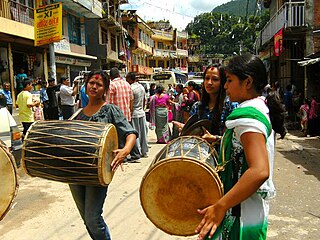
Dhimay, Dhimaya or Dhime is a traditional Nepalese drum of the Newar people. According to the Hornbostel–Sachs classification, it belongs to the category of double-headed cylindrical membranophone.
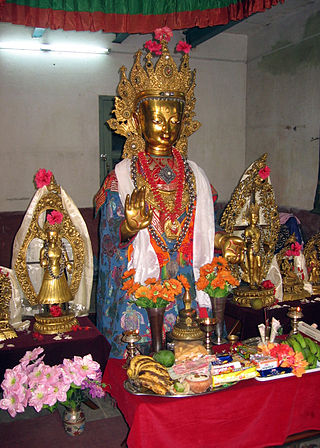
Newar Buddhism is the form of Vajrayana Buddhism practiced by the Newar people of the Kathmandu Valley, Nepal. It has developed unique socio-religious elements, which include a non-monastic Buddhist society based on the Newar caste system and patrilineality. The ritual priestly (guruju) caste, vajracharya and shakya form the non-celibate religious clergy caste while other Buddhist Newar castes like the Urāy act as patrons. Uray also patronise Tibetan Vajrayana, Theravadin, and even Japanese clerics. It is the oldest known sect of the Vajrayana tradition outdating the Tibetan school of Vajrayana by more than 600 years.

Newar caste system is the system by which Newārs, the historical inhabitants of Kathmandu Valley, are divided into groups on the basis of Vedic varna model and divided according to their hereditary occupations. First introduced at the time of the Licchavis, the Newar caste system assumed its present shape during the medieval Malla period. The Newar caste structure resembles more closely to North India and Madheshis than that of the Khas 'Parbatiyas' in that all four Varna and untouchables are represented. The social structure of Newars is unique as it is the last remaining example of a pre-Islamic North Indic civilisation in which Buddhist elements enjoy equal status with the Brahmanic elements.

The Santal people love music and dance. Like other Indian people groups, their culture has been influenced by mainstream Indian culture and by Western culture, but traditional music and dance still remain. Santal music differs from Hindustani classical music in significant ways. Onkar Prasad has done the most recent work on the music of the Santal but others preceded his work, notably W. G. Archer who collected and analyzed hundreds of Santal songs in the mid-twentieth century. The Santal traditionally accompany many of their dances with two drums: the Tamak' and the Tumdak'. The flute was considered the most important Santal traditional instrument and still evokes feelings of nostalgia for many Santal.
Maharjan, is one of the Hindu Buddhist Newar castes or groups of Nepal, predominantly from Patan, Kirtipur, Bhaktapur and Kathmandu in Kathmandu Valley.. They are a major subgroup of the Jyapu ज्यापू: community inside the Newar community. Maharjan people along with the other subgroups of the same community are also known as Jyapus.
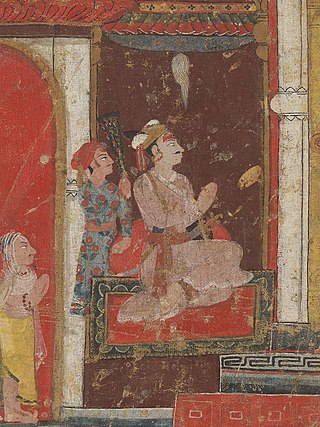
Ranajita Malla was a Malla Dynasty King of Bhaktapur, Nepal from 1722 to 1769. He was the last Malla king of Bhaktapur and of Nepal who left for Kashi after his defeat by the Gorkhali forces of Prithivi Narayan Shah. He is widely known for his contributions to Nepal Bhasa literature. Ranajit Malla is also known for his democratic values and was known to allow his citizens to openly criticize him.

Nepal Bhasa journalism began in 1925 with the publication of the magazine Buddha Dharma wa Nepal Bhasa. It was the first magazine to be published in Nepal Bhasa. It was published from Kolkata, India by Dharmaditya Dharmacharya.

Nepal Mandala is an ancient confederation on the Indian subcontinent, marked by cultural, religious and political boundaries which lies in present-day central Nepal. It consists of the Kathmandu Valley and surrounding areas. The rule of the indigenous Newars in Nepal Mandala ended with its conquest by the Gorkha Kingdom and the rise of the Shah dynasty in 1768.

The Battle of Bhaktapur was the final campaign in the Gorkha conquest of Nepal. It took place in Bhaktapur in 1769, and resulted in the victory of the Gorkhali king Prithvi Narayan Shah, giving him control of the entire Kathmandu Valley and adjoining areas.
Dapha music is a Newa artform in which singers and musicians perform devotional music, based on classical raga and taal system. The music is performed by a group of musicians called Dapha khalah in places called dabu. Dapha is the oldest surviving devotional music of Nepal, with its origin in the 17th century. The dapha music saw a growth in the early 18th century with royal patronage. It expanded during that era to include sets of nine different drums that are standard today.
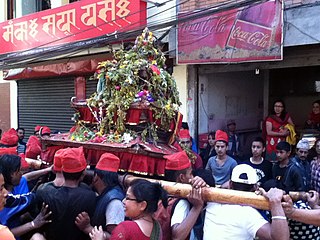
Pāhān Charhe also known as Pāsā Charhe is one of the greatest religious festivals of the year in Nepal Mandala. It is celebrated with particular fervor in Kathmandu, and consists of a conglomeration of activities including parades, masked dances, horse racing and religious worship held over three days in different places.
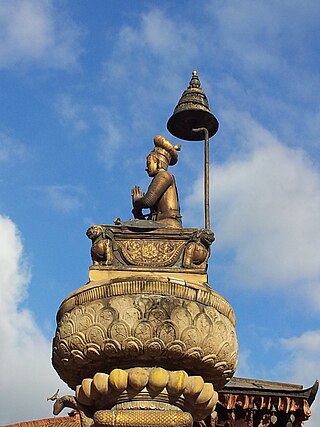
The Śreṣṭha or is the second largest Newar caste group, occupying around 21% of overall Newar population, or about 1.1% of Nepal’s total population. It is believed that the word Srēṣṭha is derived from the Newar word Śeśyah, which itself is derivation of a Sanskrit word Sista meaning 'noble', although literal meaning of the word also translated to 'best or important.' "Shrestha" itself was later adopted as the specific family surname by members of this high-caste Hindu group, although there are over 50 other recognized surnames of Srēṣṭhas. Despite their numerically low national population, their high-status and socio-economic capital puts Śreṣṭhas amongst the most socio-economically privileged and politically over-represented segments of Nepali population.
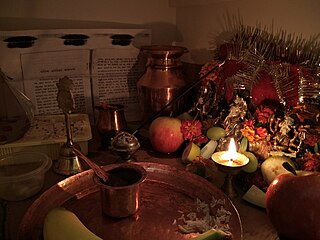
Malshree or Malashree Dhun or Malshree Dhoon is a Hindu Newa artform in which musicians perform devotional music, based on classical raga and taal system. The dhun is incorporated into mainstream Nepalese music as the music of Dashain. It is the tune that announces that Dashain, the biggest Hindu festival of Nepal, has arrived. Malashree dhun is one of the oldest surviving devotional musics of Nepal, with its origin in the 17th century. The Malshree dhun originally belongs to the Newari culture from the Kathmandu valley, and it’s a folk music of Newari culture which later on got amalgamated with the large Nepali culture and has become a traditional music of the biggest festival of Nepal, Dashain.




















